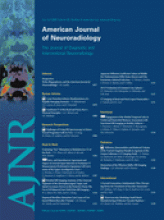Abstract
SUMMARY: This study describes a case of a patient with traumatic rupture of a maxillary sinus retention cyst, which had an interesting clinical presentation of unilateral rhinorrhea, mimicking a CSF leak. The diagnosis was made fortuitously by comparison of a posttraumatic CT brain examination with a CT sinus study performed 1 day earlier.
Maxillary sinus retention cysts are common incidental findings on imaging and are usually of no clinical significance. Retention cysts that resolve on follow-up imaging are thought to spontaneously rupture, but there is rarely any clinical history or imaging to support this theory. We present the case of a patient with traumatic rupture of a maxillary sinus retention cyst that presented with unilateral rhinorrhea, a symptom concerning for a CSF leak.
Case Report
An 18-year-old white woman presented with neck pain after a traumatic injury during a cheerleading maneuver. She was holding another cheerleader overhead when her partner lost balance and abruptly landed on top of the patient's head. Immediately after the accident, the patient noticed clear drainage from the left nostril for approximately 10 seconds, which ceased spontaneously. There was no clear loss of consciousness, facial pain, or headache. Medical history was significant for classic migraine headache and inflammatory sinus disease. Results of neurologic and facial soft tissue examinations were normal.
CT brain examination after trauma demonstrated a fluid-level in the left maxillary sinus (Fig 1) without a facial bone fracture. There was no skull base fracture on thin-section multidetector CT. Further questioning revealed that the patient had a CT sinus study performed the day earlier at another institution. This study was retrieved for comparison and showed a smooth, convex soft tissue mass in the left maxillary sinus consistent with a retention cyst (Fig 2). The cyst was also noted on a MR imaging study of the brain from 1 month earlier. These serial imaging studies confirmed the diagnosis of left maxillary retention cyst rupture as the cause of unilateral rhinorrhea and left maxillary sinus fluid-level. The patient made an uneventful recovery.
A, Axial CT in an 18-year-old woman performed after head trauma shows a fluid-level (arrow) in the left maxillary sinus. B, Reformatted coronal CT scan shows no evidence of fracture. Changes of previous left functional endoscopic sinus surgery are noted.
Axial (A) and coronal (B) CT scans from CT sinus study performed the day before the head trauma show a retention cyst (arrows) in the left maxillary sinus.
Discussion
In patients with head trauma, the most important differential for unilateral rhinorrhea is CSF leak or fistula. This is the result of an osseous and dural defect at the skull base, connecting the subarachnoid space to the paranasal sinus. There are several invasive and noninvasive imaging options to investigate CSF leaks,1 but before such studies are performed, the radiologist and clinician should consider benign differentials for posttraumatic rhinorrhea. This case illustrates that unilateral rhinorrhea and a sinus fluid-level on imaging can be caused by a ruptured maxillary sinus retention cyst.
Retention cysts are a common incidental and asymptomatic finding in the paranasal sinuses, which are seen in up to 13% of CT and MR imaging examinations.2 Although commonly known as “mucous retention cysts,” 2 types of retention cysts exist: mucous and serous.3 Mucous retention cysts are more common and are caused by the obstruction of a seromucinous gland. Serous retention cysts result from the accumulation of fluid in the submucosal layer. Both types of retention cysts appear as smooth, outwardly convex soft tissue masses on imaging.
Most retention cysts remain unchanged between studies, but in some cases the retention cyst may resolve completely.4 The accepted theory is that the fluid-filled sac ruptures and the cyst disappears. Despite the high incidence of the retention cysts, to our knowledge, there is no literature describing the symptoms of retention cyst rupture. Only 1 case report describes the spontaneous cyst-rupture sequence documented on plain radiographs.5
The case of this patient shows that maxillary retention cysts can rupture with blunt head trauma. It is more important to note that it serves as a reminder to consider ruptured retention cyst as a benign cause of unilateral rhinorrhea and a maxillary sinus fluid-level. Although comparison with previous imaging is helpful, even without previous studies the diagnosis should be considered before embarking on invasive and costly investigations for traumatic CSF leak.
- Received November 4, 2008.
- Accepted after revision November 10, 2008.
- Copyright © American Society of Neuroradiology









